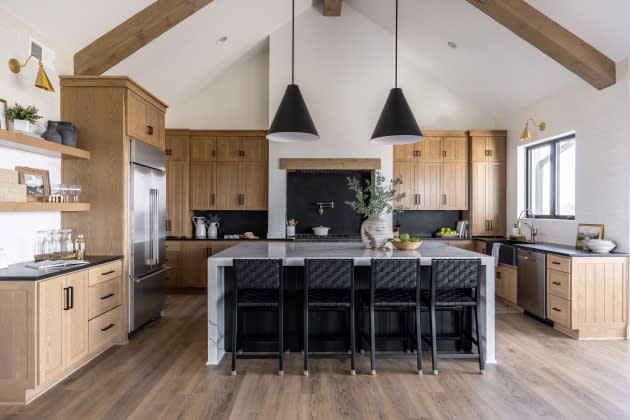How Neuroaesthetics Bring a More Human-centric Approach to Design

Over the past three years, the way we design spaces has changed dramatically. With the undeniable impact of the pandemic shifting not only how people view health and wellness, but also how they live in their homes, thoughtful, human-centric design has become paramount.
That intersection between wellness and design informs the practice of neuroaesthetics, which looks at how spaces can positively impact well-being.
More from WWD
“It’s the study of how the arts and aesthetics measurably change your brain, body and behavior,” said Susan Magsamen, founder and director of the International Arts + Mind Lab at the Center for Applied Neuroaesthetics at Johns Hopkins University. “And all that can be translated into practice.”
Neuroaesthetics was first formally defined in 2002 as the scientific study of the neural bases for the contemplation and creation of a work of art. In the two decades since, that definition has expanded to include aesthetic experiences beyond the arts, with researchers categorizing it as “the cognitive neuroscience of aesthetic experience.”
In 2016, Magsamen founded the International Arts + Mind Lab, a center for applied neuroaesthetics research at the Brain Science Institute at Johns Hopkins School of Medicine. In the years since, she has partnered with Ivy Ross, vice president of hardware products design at Google, who also has served in design and marketing roles at Gap Inc., The Disney Store, Art.com and Old Navy, to conduct research exploring the concept.
Magsamen and Ross cowrote a book on neuroaesthetics, “Your Brain on Art: How the Arts Transform Us,” that outlines some of their research. One of those studies carried out in Milan featured several room settings with distinctive features such as curved ceilings or geometric patterns designed to amp up the neuroaesthetics. Study participants walked through the rooms wearing bands that monitored physiological responses in the body as they entered each vignette.
“Fifty-eight percent of the time, what people’s bodies felt was different than their cognitive mind,” Ross said. “The lesson was our body is feeling all the time. And I think we walk around so much in our heads, and you may walk into a space and go, ‘Oh, my friend has a living room like that — I like it.’ But your body is actually not comfortable in this environment.”
Neuroaesthetics addresses the divide between what we think we like and what our bodies in fact find soothing and appealing. One of the keys to bridging this divide is acknowledging that while humans are cerebral creatures, our five senses play a major role in how we interact with our surroundings. Those interactions are distinct and different for each person.
“Our neurobiology is different from each other,” Magsamen said. “We know that how I experience a space and what I need in a space is going to be different than what you may need. And along with this idea that we are feeling creatures that think, it’s also important to note that we’re individuals.”
That attention to individuality is particularly important when designing inclusive spaces. Magsamen said the growing awareness and understanding of neurodivergence has begun to impact how designers and architects approach their work, especially in public spaces.
“I’m seeing more knowledge about, for example, how light may inform autistic children and adults, and how you accommodate that in public spaces,” she said. “You have to think about things like making sure that there are opportunities for different types of movement within spaces, different colors, different textures. Not all designers are designing for that, but there is definitely a movement towards that.”
In the home, striking a balance between appealing to the senses and maintaining functionality informs the use of neuroaesthetic design.
“We need to make sure that we’re designing for what the outcomes are in a home,” Magsamen said. “So sometimes a home is a respite. Sometimes it’s a place for attention or sometimes it’s a place for community. Designing for function is very different than when you’re designing for feeling.”
While it may sound daunting to design functional spaces that meet the needs of everyone living in or using them, some universal elements can be incorporated that will appeal to a wide range of people.
“The default here I think is always nature,” Ross said. “We know that nature across all of these different variances is an equalizer. Just being in a garden or around plants immediately lowers your blood pressure and cortisol.”
As the idea of neuroaesthetics becomes more widely accepted in interior design, digital tools such as smart home integrations will make it easier to intuit the needs of a space’s inhabitants.
“Technology is going to be helpful in that because, as Ivy says all the time, she doesn’t want to walk around with a band on her wrist telling her how she feels,” Magsamen said. “But you have a smart space that understands what you need.”
While neuroaesthetics may not be top of mind right now for every architectural or interior design project, Magsamen predicted that the work coming out of her lab and being done globally will help inform how spaces are built and outfitted in the future. And that future promises to be more human-focused than ever.
“The research is strong and continuing to grow,” Magsamen said. “And that will continue to be another tributary into this well of knowledge that designers can use. This marriage of technology, science and design is a really beautiful triad.”
Best of WWD
